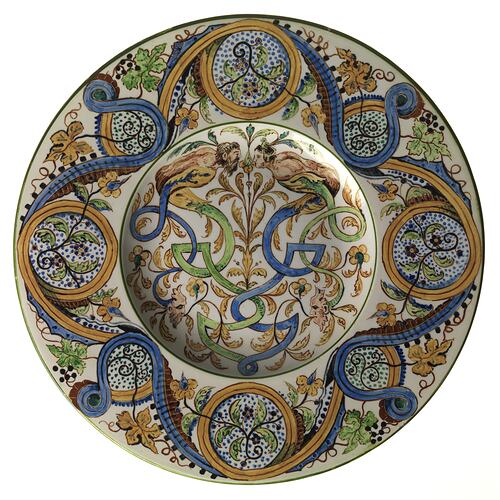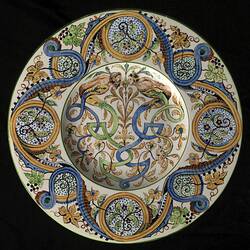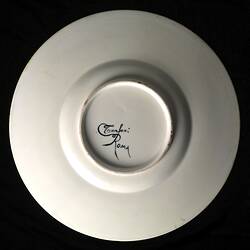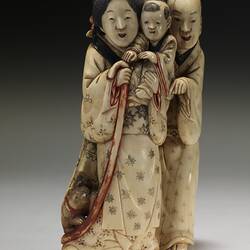Summary
Italian majolica tin-glazed charger featuring an elaborate design of two mythical figures entwined in foliage, manufactured by C. Tanfani, Rome, circa 1880. C. Tanfani's display of vases in majolica, Etruscan vases, and flower-baskets was awarded a Third Order of Merit (certificate).
Majolica, or maiolica ware is a term traditionally applied to a type of tin-glazed earthenware, popular in Italy during the Renaissance. The term is now more broadly applied to any form of tin-glazed ceramic ware influenced by the original Italian majolica and was considered highly collectable in the late nineteenth century.
The technique developed in the Middle East during the 9th century, befored spreading arcoss the Mediterranean, from Spain into Italy, via the island Majorca, from where the Italian term for this style of ceramic derives.
The earthenware object is first fired at a relatively low temperature before being dipped into a fast-drying glazek, which provides the warm, white background colour onto which the later designs are painted. Once this initial base glaze is dried, the design is painted in tin-based glazes and subsequently fired a second time at a higher temperature, producing the deep, rich colours so typical of this style of ceramic.
Physical Description
Earthenware charger, cream underlay. The centre painted with two figures growing from stylised plants. A pattern of flowers, tendrils, vines, etc. in yellow, blue, green and black around rim.
More Information
-
Collection Names
-
Collecting Areas
-
Acquisition Information
Cultural Gifts Donation from Dr Will Twycross, 23 Jan 2009
-
Acknowledgement
Donated through the Australian Government's Cultural Gifts Program
-
Manufacturer
-
Place & Date Exhibited
Royal Exhibition Building (REB), Carlton, Greater Melbourne, Victoria, Australia, 1880-1881
-
Collector
Mr John Twycross, Elsternwick, Greater Melbourne, Victoria, Australia, 1881
-
Inscriptions
Hand painted signature on underside: Tanfani/ ROMA
-
Classification
Royal exhibition building, International exhibitions, Exhibition heritage
-
Category
-
Discipline
-
Type of item
-
Overall Dimensions
320 mm (Width), 40 mm (Height)
-
Maximum dimensions
38 mm (Height), 309 mm (Circumference)
Measurement From Conservation.
-
Keywords
Decorative Arts, Earthenware, Exhibitions: Melbourne International, 1880-1881, Italian Art, Royal Exhibition Building




